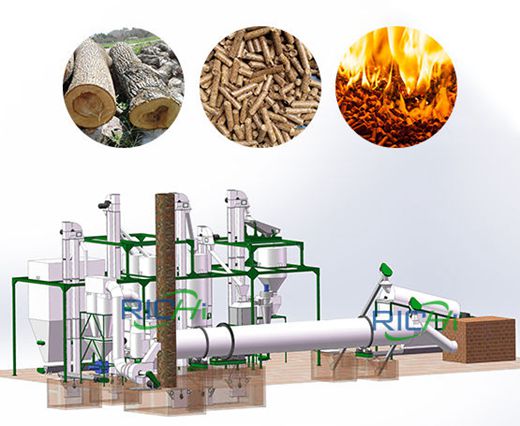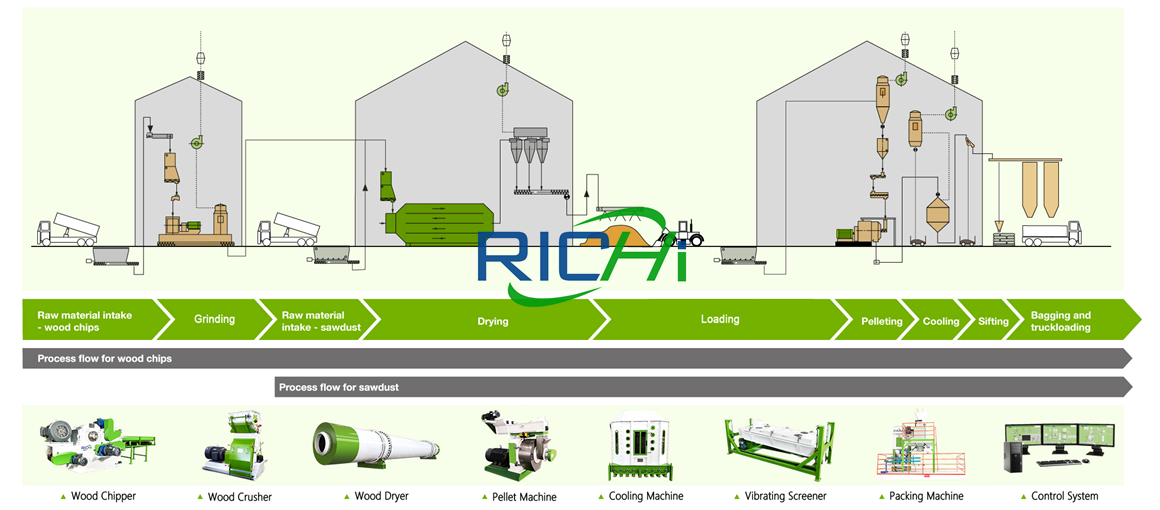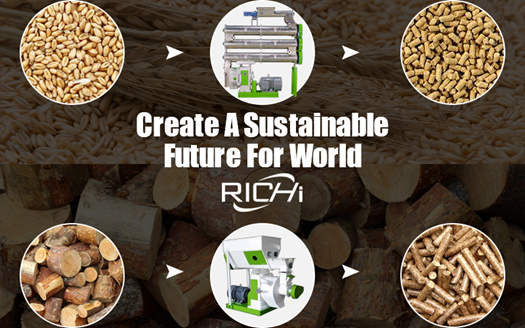Wood pellet processing plant
Contents |
[edit] Introduction
Wood pellet plants combine the complete procedure of biomass particle production, including all processes from drying out to squashing, granulation, cooling, testing and packaging. Plant may be arranged or customised in a variety of ways according to need as well as the degree of automation in cooling, packaging, and feeding.
[edit] Process
Appropriate raw materials are selected for natural fibres such as logs, branches, sawdust, rice husks, etc. These enter by conveyor belt and are sent to the wood hammer mill. On leaving in a crushed form these are directly send onward by the screw conveyor. This leads into the drum, similar to a clothes dryer, where materials are mixed with hot air. The dried material is accumulated by a cyclone separator, and then exits from the bottom of the airlock.
The next stage is the conditioner which is entered again via the screw conveyor, this conditions the material to the ideal level. Once achieving the intended moisture level the material is sent to the pelletising chamber, this performs a granulation process, with the material exiting as small round pellets of 2-12mm. The pellets then enter the cooler, drying the pellets to below 10%, and also cooling them to a regular temperature.
The remaining powder passes through the rotary category screener, which can separate out unqualified materials and granulate these once again. The screened pellets are loaded by an automated weighing device and then sealed by an automatic stitching device.
The complete set that makes up a wood pellet plant is not just timber pellet production equipment, it also a variety other treatment equipment according to the sort of resources and humidity.
If the raw materials arrives in larger sizes such as whole branches, it needs to be crushed into timber chips less than 5mm by a separate crusher, if it arrives smaller it can enter directly. If the humidity of the raw material is 15%-20%, it can enter the device directly, if it is higher than 20%, it has to be dried to 15-20% prior to granulation.
[edit] Renewable
As a renewable fuel, timber pellets have several advantages, such as high calorific worth, reduced emissions, huge particle proportion or compression after moulding, small volume, and combustion resistance. They have a higher level of processing than wood chips but due to their form can often be used more easily in small and large automated heaters, from industry to individual homes as an alternative fuel. Wood pellets can also utilise wood waste from saw mills and carpentry workshops.
Making use of wood pellets as a fuel is a realistic alternative environmental power resource that can help reduce carbon emissions, and has been used both in rural and urban locations.
[edit] Related articles on Designing Buildings
Featured articles and news
The UK's Modern Industrial Strategy: A 10 year plan
Previous consultation criticism, current key elements and general support with some persisting reservations.
Building Safety Regulator reforms
New roles, new staff and a new fast track service pave the way for a single construction regulator.
Architectural Technologist CPDs and Communications
CIAT CPD… and how you can do it!
Cooling centres and cool spaces
Managing extreme heat in cities by directing the public to places for heat stress relief and water sources.
Winter gardens: A brief history and warm variations
Extending the season with glass in different forms and terms.
Restoring Great Yarmouth's Winter Gardens
Transforming one of the least sustainable constructions imaginable.
Construction Skills Mission Board launch sector drive
Newly formed government and industry collaboration set strategy for recruiting an additional 100,000 construction workers a year.
New Architects Code comes into effect in September 2025
ARB Architects Code of Conduct and Practice available with ongoing consultation regarding guidance.
Welsh Skills Body (Medr) launches ambitious plan
The new skills body brings together funding and regulation of tertiary education and research for the devolved nation.
Paul Gandy FCIOB announced as next CIOB President
Former Tilbury Douglas CEO takes helm.
UK Infrastructure: A 10 Year Strategy. In brief with reactions
With the National Infrastructure and Service Transformation Authority (NISTA).
Ebenezer Howard: inventor of the garden city. Book review.
The Grenfell Tower fire, eight years on
A time to pause and reflect as Dubai tower block fire reported just before anniversary.
Airtightness Topic Guide BSRIA TG 27/2025
Explaining the basics of airtightness, what it is, why it's important, when it's required and how it's carried out.
Construction contract awards hit lowest point of 2025
Plummeting for second consecutive month, intensifying concerns for housing and infrastructure goals.
Understanding Mental Health in the Built Environment 2025
Examining the state of mental health in construction, shedding light on levels of stress, anxiety and depression.
























